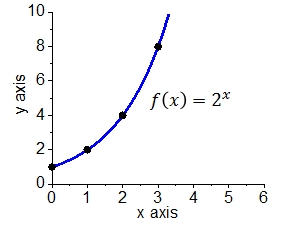Operations for functions: Exponential and logarithmic functions
 Exponential functions
Exponential functions
Exponential functions occur naturally in real life. Consider, for example, the number of bacteria that grow in a culture medium where each minute every bacterium splits into two bacteria. If we start with one bacterium, then after one minute we have two bacteria, after 2 minutes 4 bacteria, and so on:
| Time (in minutes) | Number of bacteria |
| 0 | 1 |
| 1 | 2 |
| 2 | 4 |
| 3 | 8 |
| 4 | 16 |
| 5 | 32 |
If is the number of minutes that have passed and is the number of bacteria, the equation that describes the growth is

The function is an of an example of an exponential function:
Exponential function
If is a positive real number, then the function
The reason for requiring the base to be positive is related to the fact that for negative values of the power is not always defined. For example, if and , then is a number squaring to , but no such number is real.
Later we will see that, if , the exponential function grows faster than any power function.
The function , “raising to the power ”, where the independent variable is the base , is a power function, but not an exponential function.

Or visit omptest.org if jou are taking an OMPT exam.



